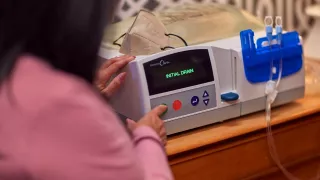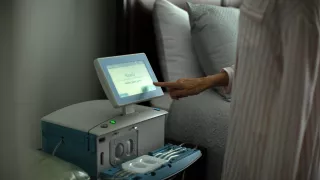
Peritoneal Dialysis Products to Promote Patient Freedom
Vantive’s automated peritoneal dialysis systems, solutions and dedicated services help people with chronic kidney disease maintain the lifestyle they choose.

Homechoice Claria APD System
Our Homechoice Claria APD System with Sharesource Connectivity Platform links clinicians and patients and simplifies PD therapy.

Amia APD System
Our Amia APD System with Sharesource Connectivity Platform is user-friendly for both clinicians and patients.

Dianeal (dextrose) Peritoneal Dialysis Solution
Our Dianeal solution portfolio offers the broadest range of dextrose concentrations and solution volumes to meet patient needs.

Extraneal (icodextrin) Peritoneal Dialysis Solution
Our one-bag-daily Extraneal solution is a non-glucose, 7.5% icodextrin solution used for the long dwell.
Renal care resources to support clinicians
We offer a wealth of resources that provide detailed information on using our APD systems, our Sharesource Connectivity Platform and our support services for both clinicians and patients.
Important Safety Information
INTENDED USE
The Sharesource portal is intended for use by healthcare professionals to remotely communicate new or modified treatment parameters with compatible dialysis instruments and transfer completed treatment data to a central database to aid in the review, analysis, and evaluation of patients’ historical treatment results. This system is not intended to be a substitute for good clinical management practices, nor does its operation create decisions or treatment pathways.
_____
INTENDED USE
Homechoice Claria APD System is intended for automatic control of dialysis solution exchanges in the treatment of pediatric and adult renal failure patients undergoing peritoneal dialysis in the home healthcare environment including comparable use in professional healthcare facilities.
_____
INTENDED USE
The Amia Automated PD System is intended for automatic control of dialysate solution exchanges in the treatment of adult renal failure patients undergoing peritoneal dialysis. All therapies using the Amia Automated PD System must be prescribed and performed under the responsibility of a physician who is familiar and well informed about peritoneal dialysis.
_____
INDICATIONS AND IMPORTANT RISK INFORMATION
Dianeal peritoneal dialysis solutions are indicated for patients in acute or chronic renal failure. Please read the accompanying Important Risk Information and full Prescribing Information.
Dianeal Solution is contraindicated in patients with severe lactic acidosis.
Peritonitis has been associated with Dianeal Solution use. Following use, inspect the drained fluid for the presence of fibrin or cloudiness, which may indicate the presence of peritonitis. Improper clamping or priming sequence may result in infusion of air into the peritoneal cavity, which may result in abdominal pain and/or peritonitis. If peritonitis occurs, treat with appropriate therapy.
Encapsulating Peritoneal Sclerosis (EPS), sometimes fatal, is a complication of peritoneal dialysis therapy and has been reported in patients using Dianeal Solution.
Monitor patients with conditions known to increase the risk of lactic acidosis [e.g., severe hypotension or sepsis that can be associated with acute renal failure, hepatic failure, inborn errors of metabolism, and treatment with drugs such as nucleoside/nucleotide reverse transcriptase inhibitors (NRTIs)] before the start of treatment and during treatment with lactate‐based peritoneal dialysis solutions.
Over-infusion of peritoneal dialysis solution volume into the peritoneal cavity may be characterized by abdominal distention, feeling of fullness and/or shortness of breath. Drain the peritoneal dialysis solution from the peritoneal cavity to treat over-infusion.
Peritoneal dialysis may affect a patient’s protein, water‐soluble vitamin, potassium, bicarbonate, calcium, and magnesium levels and volume status. Monitor hematology, electrolytes, blood chemistry and fluid status periodically and take appropriate clinical action.
Potassium is omitted from Dianeal solutions because dialysis may be performed to correct hyperkalemia. In situations where there is a normal serum potassium level or hypokalemia, addition of potassium chloride (up to a concentration of 4 mEq/L) to the solution may be necessary to prevent severe hypokalemia.
Monitor fluid status to avoid hyper‐ or hypovolemia and potentially severe consequences including congestive heart failure, volume depletion and hypovolemic shock.
Dianeal Solution contains dextrose and may increase the risk for hyperglycemia in patients with impaired glucose tolerance. Patients may require initiation or modification of antidiabetic therapy during treatment with Dianeal Solution. Monitor blood glucose.
There is a potential for overdose resulting in hypervolemia, hypovolemia, electrolyte disturbances or hyperglycemia. Excessive use of Dianeal Solution with 4.25% dextrose during a peritoneal dialysis treatment can result in significant removal of water from the patient.
Please click here for full Prescribing Information.
_____
INDICATIONS AND IMPORTANT RISK INFORMATION (IRI)
INDICATION
Extraneal (icodextrin) is indicated for a single daily exchange for the long (8- to 16- hour) dwell during continuous ambulatory peritoneal dialysis (CAPD) or automated peritoneal dialysis (APD) for the management of kidney failure in patients requiring long-term kidney replacement therapy. Extraneal is also indicated to improve (compared to 4.25% dextrose) long-dwell ultrafiltration and clearance of creatinine and urea nitrogen in patients with high average or greater transport characteristics, as defined using the peritoneal equilibration test (PET).
IMPORTANT RISK INFORMATION
- Extraneal is contraindicated in patients with a known hypersensitivity to icodextrin, in patients with maltose or isomaltose intolerance, in patients with glycogen storage disease, and in patients with severe lactic acidosis.
- When measuring blood glucose levels in patients using Extraneal, do not use blood glucose monitoring devices using glucose dehydrogenase pyrroloquinolinequinone (GDH-PQQ)-, glucose-dye-oxidoreductase (GDO)-, and some glucose dehydrogenase flavin-adenine dinucleotide (GDH-FAD)-based methods because these systems may result in falsely elevated glucose readings (due to the presence of maltose). Falsely elevated glucose readings have led patients or health care providers to withhold treatment of hypoglycemia or to administer insulin inappropriately leading to unrecognized hypoglycemia. Falsely elevated glucose levels may be measured up to two weeks following cessation of Extraneal therapy when GDH-PQQ-, GDO-, and GDH- FAD-based blood glucose monitors and test strips are used. Additionally, other glucose-measuring technologies, such as continuous glucose monitoring systems, may or may not be compatible with Extraneal. Always contact the device manufacturer for current information regarding compatibility and intended use of the device in the dialysis patient population.
- Extraneal is intended for intraperitoneal administration only. Not for intravenous or intra-arterial administration. Aseptic technique should be used throughout the peritoneal dialysis procedure.
- Encapsulating peritoneal sclerosis (EPS), sometimes fatal, is a complication of peritoneal dialysis therapy and has been reported in patients using Extraneal.
- Serious hypersensitivity reactions to Extraneal have been reported such as toxic epidermal necrolysis, angioedema, serum sickness, erythema multiforme and vasculitis. Anaphylactic or anaphylactoid reactions may occur. If a serious reaction is suspected, discontinue Extraneal immediately and institute appropriate therapeutic countermeasures.
- Overinfusion of peritoneal dialysis solution volume into the peritoneal cavity may be characterized by abdominal distention, feeling of fullness and/or shortness of breath. Drain the peritoneal dialysis solution from the peritoneal cavity to treat overinfusion.
- Patients with insulin-dependent diabetes may require modification of insulin dosage following initiation of treatment with Extraneal. Monitor blood glucose and adjust insulin, if needed.
- Peritoneal dialysis may affect a patient’s protein, water-soluble vitamin, potassium, sodium, chloride, bicarbonate, and magnesium levels and volume status. Monitor electrolytes and blood chemistry periodically. Monitor fluid status to avoid hyper- or hypovolemia and potentially severe consequences including congestive heart failure, volume depletion, and hypovolemic shock. Abnormalities in any of these parameters should be treated promptly under the care of a physician.
- In clinical trials, the most frequently reported adverse events occurring in ≥10% of patients and more common in Extraneal PD solution patients than in control patients, were peritonitis, upper respiratory infection, hypertension, and rash. The most common treatment‐related adverse reaction for Extraneal PD solution patients was skin rash.
Click here for full Prescribing Information for Extraneal PD Solution.
Rx Only. For safe and proper use of the products mentioned herein, please refer to the appropriate Operator’s Manual or Instructions for Use.
Vantive, Amia, Dianeal, Extraneal, Homechoice Claria and Sharesource are trademarks of Vantive Health LLC or its affiliates.
